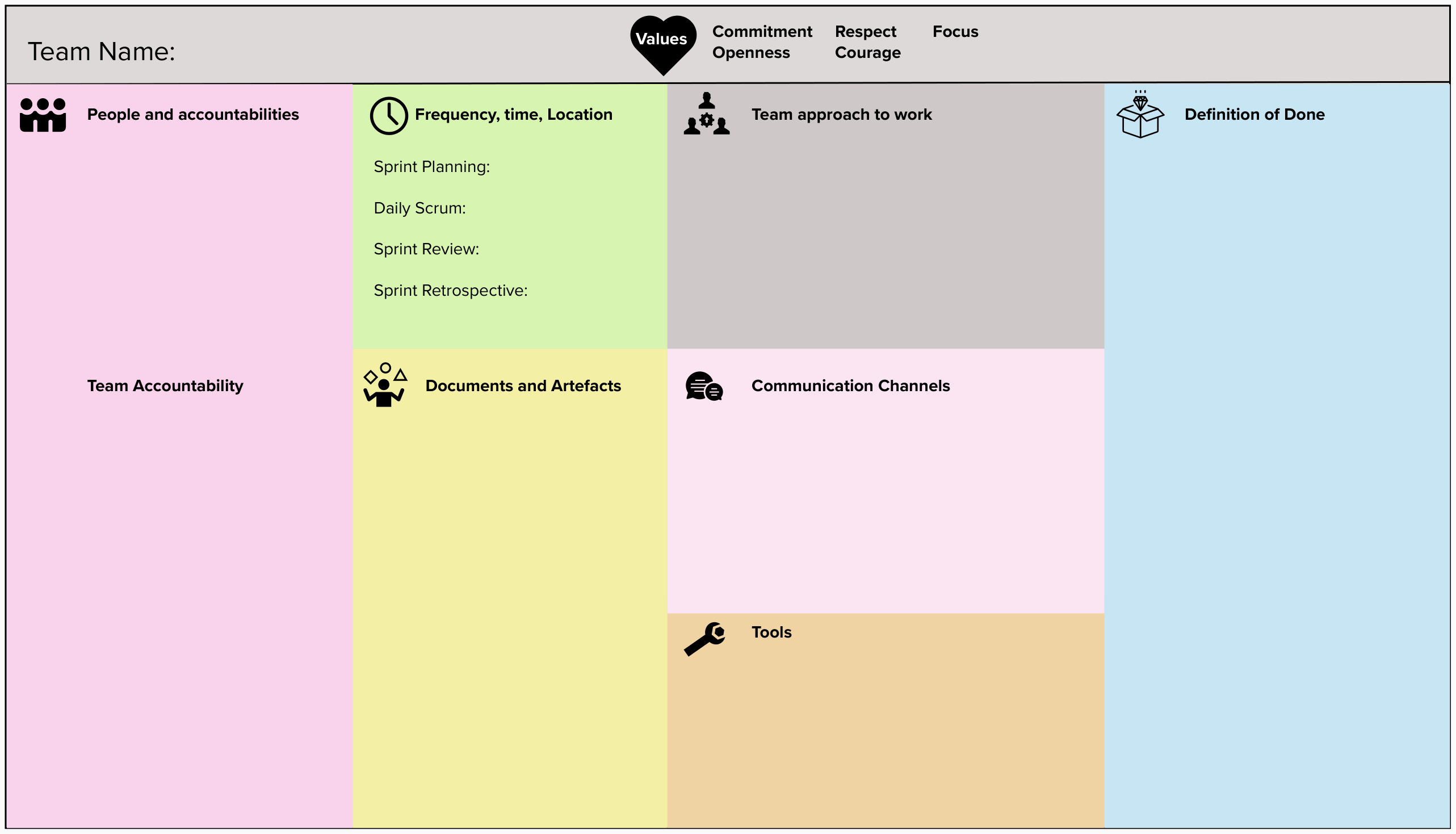Creating a Team Working Agreement
Why create a team working agreement?
A team working agreement provides an agreed upon set of guidelines for a Scrum Team to follow, so everyone understands what is expected as they work together in pursuit of delivering value. A team can use a working agreement to help them work toward self-management.
A Scrum Team creates the team working agreement collaboratively. If you are a Scrum Master, you can support the creation and evolution of the team working agreement, but you should not decide what should be in it on behalf of the team. Of course, you can contribute to it as a peer.
Facilitating a working team agreement
When facilitating the creation of a working agreement with a Scrum Team you can guide them in the conversation by falling back and calling upon the Scrum values. The Scrum values of Courage, Commitment, Focus, Openness and Respect provide direction for a Scrum Team on their behavior and actions, and so any Scrum Team working agreement should consider them.
If needed, prompt the team with open-ended questions about what the Scrum values mean to them, helping them to develop and evolve the working agreement. For example, through conversation, they may find that Respect and Commitment manifest in the working agreement by everyone agreeing to attend the Scrum events on time. Or, Focus might mean an agreement that team members will not disturb other team members during certain times of the day.
There are many different ways to create a working team agreement. "Diverge and Converge" and "Worst Possible Idea" are two activities you can try with your team.
Activity: Diverge and Converge
One way to facilitate the creation of the Scrum Team’s working agreement is by using a divergence and convergence which has two stages: the diverge stage, in which team members individually think of ideas, and a converge stage, where they discuss the ideas from the diverge phase together as a group to come to a shared understanding. This allows the team to generate a wide range of ideas and explore their different perspectives.
Activity Facilitation Guidelines
- First, encourage everyone on the Scrum Team to individually generate ideas and suggestions that they think should be part of the team working agreement. Examples they might consider are:
- The time and location of the Scrum events
- The Definition of Done
- Communication channels that the team uses
- How the team approaches work (e.g. pairing, mobbing, swarming, etc)
- How the team can focus on work and avoid too many distractions
- Tools that the team agrees to use
- Where documentation and artifacts will be stored
- How the Product Backlog and Sprint Backlog will be made transparent
- How the work environment is organized whether virtual or physical
- After the team finishes noting their suggestions, give them a chance to review and understand the output from the idea generation by using techniques such as affinity mapping or gallery walk.
- Next, the Scrum Team should understand what suggestions were made. Read each item or grouping of items aloud one-by-one for everyone to understand.
- Decide what ideas go into the working agreement using techniques (see "Five Ways to Build Consensus" blog post) such as fist to five, roman voting, or dot voting to understand individual levels of agreement on each item or set of items. (As this is the team’s collective working agreement, the team should decide together on what level of consensus they want in order for a suggestion to be included in their working agreement. Everyone agrees? Majority agrees?)
Activity: Worst Possible Idea
Another technique to use when creating a working agreement collaboratively is similar to Triz from Liberating Structures. This is another great way to facilitate the creation of a working agreement, especially with teams that struggle to come up with ideas and suggestions.
Activity Facilitation Guidelines
- Generate a first list of worst possible things a Scrum Team can do when working together
- Individually, participants can list out their ideas, group them and decide what the worst possible ideas are as described in Step 4 of Diverge and Converge, or they can use,
- Use Liberating Structure 1-2-4- All to generate an initial list of the worst possible things a Scrum can do when they work together
- Individually: team members reflect and create a list of the worst possible things a Scrum Team can do when working together (1min.)
- In pairs: team members share their results and build upon the results of the individual round (2min.)
- In groups of four: team members share and develop the results from the previous round further. (4 min.) The groups ask themselves the one thing on the list that stands out for them (5 min.)
- Entire group: Each group of four shares one worst possible thing the Scrum Team can do when working together with the entire group (5 min.)
- Generate a second list of all the behaviors and actions Scrum Team is currently doing that resembles items on the first list. Have them reflect and discuss.
- Generate ideas on how to prevent or stop these counterproductive things from happening
- Team members can list out ideas individually, group, discuss and decide what items they want to bring into their working agreement, or
- Use 1-2-4-All
- Add the ideas generated in Step 3 as a foundation to build the working agreement
Using this structure, and asking 'what should we NOT do' helps people to think creatively and reflect on their way of working.
Revisit the Working Agreement
Whatever approach your team decides to use to create their working agreement, it is important that they do not forget their working agreement exists. The Scrum Team should live by the agreement they created collaboratively and revisit it and adapt it as needed.
For the team to appreciate and consent to the team working agreement as an evolving and living artifact, it needs to be transparent and accessible to the whole team. Visualize the working agreement, either physically or virtually. It might be useful to list items into different topics like in the example.

Example of working agreement template created in a virtual whiteboard
When new team members join a team, make sure they know the working agreement exists and invite them to discuss it with the team.
Resources:
